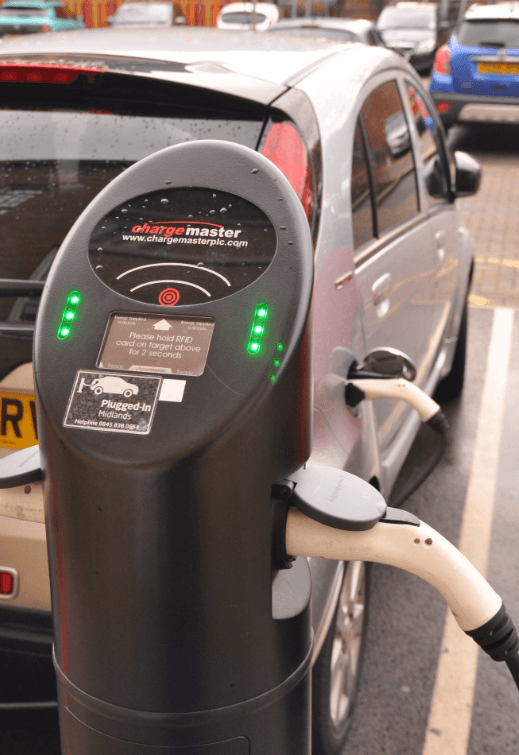
blog: What’s it like to own an electric vehicle?
Wednesday 16th June 2021
We finally got around to thinking about our next car when the existing clunker (of twelve years) went in for the dreaded MOT mid-pandemic and got a fairly big repair bill. My partner is the main user of the car - I'm lucky enough to be able to walk my commute, though we both drive a bit over the course of a week. Her daily drive is about the perfect distance for an EV - just beyond the comfortable reach of a bike, but not outside charge range for a return trip.
The Electric Vehicle

We went for a fairly common fully-electric model that's been around long enough that loads of second-hand vehicles are now available. At about 3-4 years old, they are relatively affordable, though since then even more manufacturers have got on board with some kind of plug in hybrid (‘PHEV’) or fully electric options, so there’s loads of choice. I was put off some of the hybrid options as they didn't offer the same big improvement in fuel/energy efficiency - mostly because of the larger car needed to carry two powertrains around with you. Some of them use just as much fuel as a small petrol car!
So an entry-level, four-door fully electric vehicle, four years old, can do around 110 miles on a full charge. But that varies greatly by type of trip: at 30mph, it might manage 125+ miles, whilst at 70mph on a windy day you might struggle to go 90 miles.
The Range
I would say getting used to this 'range planning' has been the biggest adjustment, and related stuff like getting used to a slightly slower journey on the motorway to minimise the need to recharge over long distances. Longer trips are the sticking point: one half of the family lives about 'one full charge' away, one-way, whilst the other is around twice that. But public charge points can give you 80% in about half an hour, which makes the journey possible, if a bit slower. And chargers are popping up all over, usually accepting contactless or needing an app. For daily use, we just charge with the 13-amp plug that came with the car: to fill it takes twelve hours (!) but this approach is cheapest and also probably better for the battery.
On costs generally - over an annual mileage of just under 10,000 we expect to save upwards of £1000 a year (I made a spreadsheet!), if you add that we're no longer paying car tax, and that servicing can be mostly DIY or more infrequently. But this big saving is wiped out by the higher cost of the car relative to a petrol model. I therefore see it as costing no more to 'do the right thing' environmentally, rather than a big money saver. But for some who live more than (say) 50mi from work, or aren’t lucky enough to have access to a driveway, it won’t be as practical.
The Drive
It's really nice to drive! Super smooth, and fast and reliable to accelerate should you need it. Whisper quiet, to the point where the ‘ignition’ sequence is strange at first – you just start moving, with almost no noise. There are a few super helpful features: you can pre-defrost your car on a cold winter day with an app or timer, and also use the same app to monitor or control charging. The sat nav has charger locations stored in it, and it can factor charge level into route planning (though we’ve never trusted this!).
The Battery
Charging takes a little getting used to – there are quite a confusing a number of different options for any one car, and sometimes a completely different set of options available at each public charge point. But most cars can do ‘slow’ charging, usually at home, and ‘rapid’ charging at motorway services, petrol stations etc. Intermediate-speed chargers (confusingly often called ‘fast’) are also increasingly common at many workplaces, car parks etc. Apps also exist to help you through this process and find reliable charge points.
One worry about EVs is the longevity of the batteries in the boot. But there are a number of things you can do to reduce wear and maximise their life – the battery chemistry is basically the same as that of mobile phones. There is also a handy ‘health’ gauge on the dashboard, so you know what you’re getting into if you buy second-hand. Some owners have reported achieving 100K or more miles in older vehicles with little trouble.
More widely – the need for decarbonising transport is urgent, with most countries struggling to make much headway, especially in transport-related emissions. An EV is not ‘zero carbon’ – it depends where you get your volts from! But the National Grid is getting better fast, and you can choose a greener energy supplier too. I’m no fan of private motoring generally: I think faster, fairer decarbonisation of transport probably should mostly come through a combination of bikes, buses and trains. A traffic jam of electric cars is still a traffic jam, after all. But EVs could play a big role in rural areas, or where cycling infrastructure is still being built.
